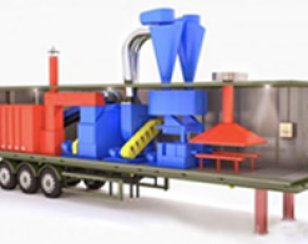Grinding in the aerodynamic dispergator
When dispergator is working, material is moved to dispergator through special loading gate and gets to rotor with blades. Material collides with blades and grinds, under inertial forces material particles tend to leave dispersion area. At the same time fan blows down air through dispergator in order to return material particles to grinding area, so, the generation of air-fluidized material bed at outer radius of horn rotation is executed. Particles traverse speed in air-fluidized bed is lower, than rotor traverse speed, that executes energy, which is necessary for material grinding. Material drying is executed owing to intensive air change. Air flow, providing drying of material, is up to 30 000 m3/hour, the flow rate is 25-28 meters/second relative to material particles, which are in a fluidized bed. Effective drying is executed when the air of temperature is 120 - 150 ° C, the approximate rate of thermal energy is 750-800 kW. to 1 tonne evaporated moisture. Grinding and drying of material is executed until material particles reach necessary size and humidity.
The combination of drying and grinding with inertial separation allows to grind materials with initial humidity to 60% by weight. Impingement attack of rotor blades to material and multiple material particles collisions in dense velocity layer allow to grind coarse material particles efficiently. Rotor rotational velocity, depending on its model, is 2000 turns per minute. During grinding process simultaneous drying is executed, it doesn’t allow material to stick to operating apparatus surface.
Applied inertial separation principle allows to take out particles of necessary size from grinding area under air flow.
Material feed may be executed by different ways: by jet transport, by auger conveyer, by belt transporter. Material selection from air flow is executed with the help of specially developed whirler by SIOT, material is precipitated to bunker.
|
|
|
|

